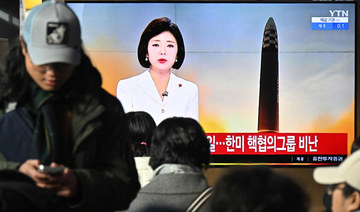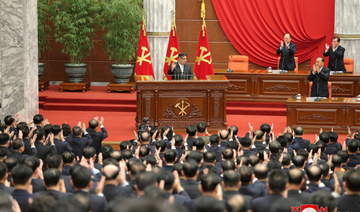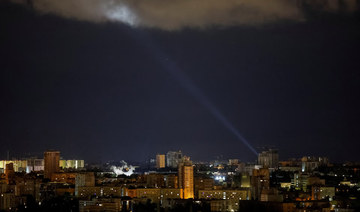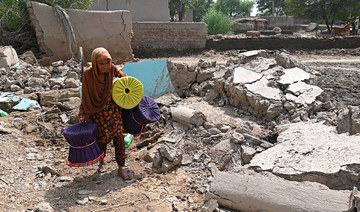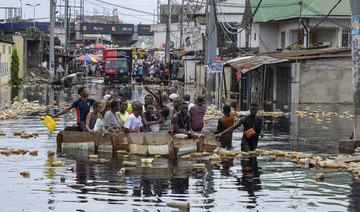SEOUL: North Korea’s recent escalation of threats and more tests of weapons aimed at South Korea haven’t done much to upset the calm in the nation’s capital.
“We learned to be numb,” said Renee Na, a 33-year-old office worker in Seoul who was one of a dozen South Koreans who sounded more indifferent than scared when talking with The Associated Press.
“Our generation grew up seeing North Korea use nuclear provocations as showmanship to maintain the stability of its regime,” Na said. “When they act up, it doesn’t feel like a real threat, but more like an annual event they stage when they need to shore up internal unity or want outside help.”
That’s a stark contrast to recent comments from Pyongyang, where leader Kim Jong Un said in January that his nation was abandoning its fundamental objective of peaceful reconciliation with South Korea. He also repeated a threat to annihilate the South if provoked.
At the same time, North Korea has conducted a streak of weapons testing, including what it described as simulated nuclear attacks on the South.
Worries about a direct provocation were amplified after the North fired hundreds of artillery shells into waters near its disputed western sea boundary with South Korea, prompting the South also to fire.
For now, there’s concern in South Korea — but not alarm.
And it’s nothing like 1994, when waves of panicked crowds emptied stores of instant ramen and rice after a North Korean negotiator threatened to turn Seoul into a “sea of fire.”
North Korea has mastered a cycle of raising tensions with weapons demonstrations and threats before eventually offering negotiations aimed at extracting concessions. The result is that many South Koreans believe North Korea is using its old playbook to get attention during an election year in South Korea and the United States.
There’s widespread doubt that North Korea, an autocracy that values the survival of the Kim dynasty over anything else, would risk war with US-backed South Korea. Washington has warned repeatedly that the North’s use of nuclear weapons would result in the end of Kim’s rule.
The fast-paced, competitive nature of life in South Korea makes it easy for many to ignore North Korean threats. And public interest here in North Korea tends to mirror the rise and fall in tensions.
“Personally, I don’t think Kim Jong Un currently has a reason or ability to wage war,” said Min Seungki, another Seoul resident. “The North Koreans clearly see a South Korean government that is unfavorable to them. They are also trying to be noticed by (Donald) Trump and the Republicans, who they prefer over the Biden administration, which didn’t show much interest in dealing with them.”
But there’s also a sense that South Korea has few options to counter the leverage Kim has with his nuclear arsenal. Years of missile launches and other weapons tests have moved Kim much closer to his goal of having a nuclear arsenal that could viably strike both his neighbors and the United States.
South Koreans are increasingly worried Washington may hesitate to defend the South if Kim has more missiles with the range to strike the US mainland.
South Koreans’ security anxieties have long been kept in check by the US-South Korea alliance and by past inter-Korean projects such as South Korean tours to the Diamond Mountain resort and the jointly operated Kaesong factory park, said Han-Wool Jeong, director of the Korea People Research Institute. Those joint economic projects, pushed by past liberal governments in Seoul, were halted as inter-Korean ties worsened under subsequent conservative governments.
Jeong said many now believe South Korea’s security depends entirely on the US-South Korea alliance.
Since taking office in 2022, conservative South Korean President Yoon Suk Yeol has moved to expand the South’s combined military exercises with the United States and Japan to cope with the North’s evolving threats. He has also sought stronger assurances from Washington that the United States will decisively protect its ally if North Korea attacked with nuclear weapons.
But those steps have not slowed Kim’s weapons demonstrations, which likely reflect confidence over his steady weapons advancement and his strengthened ties with Russia.
Some South Korean experts have called for the US to more dramatically show its defense commitment to its ally, including returning the tactical US nuclear weapons withdrawn from the South in the 1990s. Others insist the South should pursue a nuclear deterrent of its own.
While many analysts downplay the possibility of a war on the peninsula, some believe Kim may choose to raise pressure on the South with a direct but contained military action.
The poorly marked sea boundary — the site of skirmishes and attacks in past years — could be a crisis point. Both Koreas in recent months have breached their 2018 military agreement to reduce border tensions, which had established buffers and a no-fly zone.
“It’s clear North Korea wants to use the April parliamentary elections to create momentum in South Korea for Yoon’s removal from office and could possibly conduct a large provocation to increase military tensions to the maximum and try to influence voters to oppose Yoon’s hard line,” said Bong Youngshik, a North Korea expert at Seoul’s Yonsei university.
The animosity between the Koreas is keenly felt by Kim Giho, a fisherman on the western border island of Yeonpyeong, where a North Korean artillery bombardment killed four people in 2010.
“When tensions rise like this, our boats can’t move in and out of sea, and that hurts our livelihoods,” Kim said. “We are again evacuating to shelters with our military resuming firing drills and that really raises our sense of isolation, tension and fear. It’s especially traumatizing for older people who experienced the shelling of 2010.”
South Koreans stay calm as they see showmanship in the North’s escalating threats
https://arab.news/5v9sf
South Koreans stay calm as they see showmanship in the North’s escalating threats
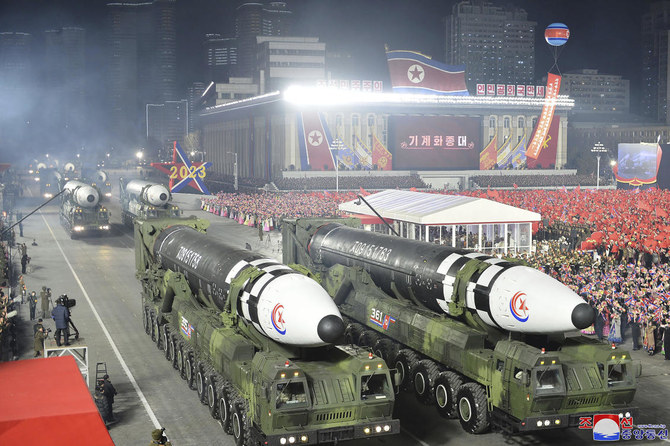
- ‘Our generation grew up seeing North Korea use nuclear provocations as showmanship to maintain the stability of its regime’
Modi critic joins India’s election campaign on bail

- Top court allows Delhi Chief Minister Arvind Kejriwal to leave custody until June 1
- His release is expected to give a boost to India’s opposition alliance in ongoing polls
NEW DELHI: Delhi Chief Minister Arvind Kejriwal joined India’s ongoing general election — boosting the opposition alliance on Saturday — a day after the Supreme Court ordered his temporary release on bail in a controversial graft case.
A fierce critic of Prime Minister Narendra Modi and the leader of the Aam Aadmi Party, Kejriwal was arrested in late March, in connection with corruption allegations related to the excise policy of the Delhi government led by him. He denies the accusations.
On Friday, the top court granted Kejriwal 21-day interim bail to campaign in the seven-phase general vote, which started on April 19. He has to surrender after the last day of voting on June 1.
“I will go around the country in the next 21 days to stop this dictatorship of Modi,” Kejriwal said at a conference in Delhi.
“After June 4, there will be no Modi government. In all states, their seats are going down and they will not get more than 220 to 230 seats.”
The results of the world’s largest election are set to be announced on June 4. The party or coalition that wins at least 272 of the 543 contested seats in the lower house of parliament will form the government.
Seeking a third straight term in office, Modi has been targeting 400 seats for the National Democratic Alliance led by his Hindu nationalist Bharatiya Janata Party, which has been in power since 2014.
He is challenged by an alliance of two dozen opposition parties, the Indian National Developmental Inclusive Alliance, or INDIA, of which Kejriwal’s AAP is a part.
Kejriwal has accused Modi and his BJP of damaging democracy, and abusing power and the constitution.
“The opposition’s morale will get a further boost,” said Satish Kumar Singh, a political analyst in Delhi.
“The release of Kejriwal further reinforces the opposition campaign on the need to save democracy and maintain fairness in the electoral process.”
Kejriwal’s AAP is a challenger to the BJP in Delhi and Punjab, where voting will take place on May 25 and June 1 respectively.
“Kejriwal’s release is a boost to the cadres of the AAP and the opposition alliance at this crucial time when the opposition alliance is challenging the dominance of the BJP in the capital city,” Andalib Akhtar, a New Delhi-based commentator and editor of The Indian Awaz, told Arab News.
“It’s good that the court has taken a decision in favor of democracy and is giving the opposition leader — who was arrested just on the eve of the general elections — an opportunity to be on an equal footing democratically.”
Saudi eye surgeons help 1,000 Sri Lankans regain sight

- KSrelief team consists of doctors from Saudi Arabia and Pakistan
- Untreated cataracts are the most common cause of blindness in Sri Lanka
COLOMBO: A Saudi eye surgeon team is helping 1,000 people in Sri Lanka regain sight with interventions facilitated by the King Salman Humanitarian Aid and Relief Center.
KSrelief’s Saudi Noor Volunteer Program to Combat Blindness started in the city of Kattankudy on Sri Lanka’s eastern coast on May 5 and will run through next week.
“This is a special program to combat blindness among patients who are suffering from a cataract,” M.S.M. Thassim, director general of KSrelief’s local partner, the Association of Muslim Youth of Sailan, told Arab News.
“From the total of 1,000 patients, 500 completed surgery and 500 more (surgeries) will be performed by May 16.”
Cataracts are the most common cause of blindness in Sri Lanka. Surgery to remove them is common, but government programs often require years of waiting. At private clinics, the cheapest lens replacement procedure costs about $300 — too expensive for many patients in poorer parts of the country.
“Cataracts are becoming a problem among the lower-middle class above the age of 40,” Thassim said.
“We perform cataract surgery and also give post-surgery treatment. The patients are from all parts of the island.”
The procedures are free of cost and conducted at the Kattankudy Base Hospital by Sri Lankan medics and six Saudi and Pakistani surgeons from KSrelief’s team.
One of the Saudi volunteers is Dr. Ehab Al-Sirhy, an eye surgeon from King Saud University Medical City in Riyadh.
“The amount of surgery done is an amazing number in such a short period,” he told Arab News, praising local hospital staff for their “excellent logistics and support.”
The medical campaign is part of KSrelief’s longstanding efforts to combat blindness in developing countries. Last year, the center’s team also visited Kattankudy and helped restore the vision of hundreds of patients.
“The results are very encouraging, so now everyone brings their friends and relatives, their grandmothers, their grandfathers,” Al-Sirhy said. “The (campaign’s) reputation is excellent.”
Russia claims more advances after Ukraine ground offensive

- Russia’s defense ministry said its troops had ‘liberated’ five border villages in the Kharkiv region
- The Kharkiv region has been mostly under Ukrainian control since September 2022
UKRAINE: Russia on Saturday said it had captured six villages in Ukraine’s east after launching a surprise ground offensive that prompted mass evacuations.
The defense ministry said its troops had “liberated” five villages in the Kharkiv region near the border with Russia — Borisivka, Ogirtseve, Pletenivka, Pylna and Strilecha — “as a result of offensive actions.”
The village of Keramik in the Donetsk region was also now under Russian control, it said.
Ukrainian officials said Russian forces made small advances in the area it was pushed back from nearly two years ago, the latest in a series of gains as Ukrainian forces find themselves outgunned and outmanned.
“A total of 1,775 people have been evacuated,” Kharkiv governor Oleg Synegubov wrote on social media.
He reported Russian artillery and mortar attacks on 30 settlements over the past 24 hours.
Groups of people could be seen coming in vans and cars with as many bags as they could carry at an evacuation arrival point outside the city of Kharkiv.
Evacuees — many of them elderly — registered and received food and medical assistance in makeshift tents.
“We must disrupt Russian offensive operations and return the initiative to Ukraine,” Ukrainian President Volodymyr Zelensky said on Saturday.
Ukrainska Pravda quoted military sources saying the Russian assault had resumed on Saturday near the village of Glyboke in Kharkiv.
The report could not be independently verified.

The Kharkiv region has been mostly under Ukrainian control since September 2022.
A senior Ukrainian military source said on Friday that Russian forces had advanced one kilometer into Ukraine and were trying to “create a buffer zone” in the Kharkiv and neighboring Sumy regions to prevent attacks on Russian territory.
Ukrainian forces have multiplied attacks inside Russia and Russian-held areas of Ukraine, particularly on energy infrastructure.
Moscow-installed authorities in the Russian-occupied Lugansk region in eastern Ukraine said four people were killed by a Ukrainian strike with US-made missiles on an oil depot in Rovenky.
Governor Leonid Pasechnik said the strike “enveloped the oil depot in fire and damaged surrounding homes.”
In Russia, two people were reported killed by Ukrainian strikes in the Belgorod and Kursk regions.
Ukrainian officials also reported a total of six civilians killed in Russian shelling in the Donetsk, Kharkiv and Kherson regions over the past day.
Officials in Kyiv had warned for weeks that Moscow might try to attack its northeastern border regions, pressing its advantage as Ukraine struggles with delays in Western aid and manpower shortages.
Ukraine’s military said it had deployed more troops and Zelensky said Ukrainian forces were using artillery and drones to thwart the Russian advance.
“Reserve units have been deployed to strengthen the defense in this area of the front,” it said.
The US-based Institute for the Study of War said on Friday that Russia had made “tactically significant gains.”
But the main aim of the operation was “drawing Ukrainian manpower and material from other critical sectors of the front in eastern Ukraine,” it said.
ISW said it did not appear to be “a large-scale sweeping offensive operation to envelop, encircle and seize Kharkiv” — Ukraine’s second biggest city.
Washington announced a new $400 million military aid package for Kyiv hours after the offensive began, and said it was confident Ukraine could repel any fresh Russian campaign.
Heavy rains set off flash floods in northern Afghanistan, killing at least 200 people: UN report says

ISLAMABAD: Flash floods from seasonal rains in Baghlan province in northern Afghanistan killed at least 200 people on Friday, UN report said.
The floods also caused losses to homes and property in several districts, according to Edayatullah Hamdard, the provincial director of Natural Disaster Management in Baghlan. He said that the death toll was preliminary and that it “might rise as many people are missing.”
The flash floods also hit the capital, Kabul, said Abdullah Janan Saiq, the Taliban’s spokesman for the State Ministry for Natural Disaster Management. He said that rescue teams bringing food and other aid have been dispatched to the affected areas.
Saiq said that the rescue operation is the main focus of authorities at the moment, and that he later might be able to provide more precise figures on casualties and damage.
Emergency personnel were “searching for any possible victims under the mud and rubble, with the help of security forces from the national army and police,” Hamdard said earlier.
Dozens of tents, blankets and food were provided to those who lost their homes, he added.
Video footage seen on social media showed huge torrents of muddy water swamping roads and bodies shrouded in white and black cloth.
In one video clip, children are heard crying and a group of men are looking at floodwaters, in which bits of broken wood and debris from homes can be seen.
Since mid-April, flash flooding and other floods have left about 100 people dead in 10 of Afghanistan’s provinces, with no region entirely spared, according to authorities.
Farmland has been swamped in a country where 80 percent of the more than 40 million people depend on agriculture to survive.
Rains on Friday also caused heavy damages in northeastern Badakhshan province and central Ghor province, officials said.
Taliban government spokesman Zabihullah Mujahid said authorities would provide support to those impacted by the flooding across the country.
The government “expresses its deep sympathy with the families of dead and wounded, and instructs the ministry of natural disaster management, ministries of defense and interior, and provincial authorities to spare no resource in rescue efforts,” he said in a statement on X, formerly Twitter.
Mohammad Akram Akbari, the provincial director of natural disaster management in Badakhshan, said the mountainous province had seen “heavy financial losses in several areas... due to floods.”
He added that casualties were feared in Tishkan district, where flooding had blocked a road and cut off access to an area where some 20,000 people lived.
Afghanistan — which had a relatively dry winter, making it more difficult for the soil to absorb rainfall — is highly vulnerable to climate change.
In April, at least 70 people died from heavy rains and flash flooding in the country. About 2,000 homes, three mosques, and four schools were damaged last month. Thousands of people require humanitarian assistance. The flooding also damaged agriculture land and 2,500 animals died in the deluges, according to Saiq.
The nation, ravaged by four decades of war, is one of the poorest in the world and, according to scientists, one of the worst prepared to face the consequences of global warming.
Afghanistan, which is responsible for only 0.06 percent of the world’s greenhouse gas emissions, ranks sixth on the list of countries most at risk from climate change, experts say.
Half of Afghanistan’s population lives under the poverty line, and 15 million people are experiencing food insecurity, according to the World Bank.
Police arrest dozens as they break up pro-Palestinian protests at several US universities

- Israel has killed more than 34,700 Palestinians, according to Gaza’s Health Ministry
- Nearly 2,900 people have been arrested at 57 colleges and universities
NEW YORK: Police made dozens of arrests as pro-Palestinian protest encampments were dismantled Friday at the University of Pennsylvania and the Massachusetts Institute of Technology, hours after police tear-gassed demonstrators and took down a similar camp at the University of Arizona.
Philadelphia and campus police at Penn took action around daybreak to remove protesters from an encampment in place for more than two weeks. School officials said protesters were given warnings and the chance to leave without being detained. About 33 people, including faculty members and seven students, were among those arrested and charged with trespass, the school said.
Protest camps have sprung up across the US and in Europe in recent weeks as students demand their universities stop doing business with Israel or companies that support its war efforts. Organizers seek to amplify calls to end Israel’s war against Hamas in Gaza, which they describe as a genocide against the Palestinians. The top United Nations court has concluded there is a “plausible risk of genocide” in Gaza — a charge Israel strongly denies.
In Cambridge, Massachusetts, police in riot gear arrived at MIT around 4 a.m., encircled the camp and gave protesters about 15 minutes to leave. Ten students who remained were arrested, the university’s president said. A crowd outside the camp began chanting pro-Palestinian slogans but was quickly dispersed.
At the University of Arizona in Tucson, campus police in riot gear fired tear gas at protesters late Thursday — the day before the school’s main commencement ceremony — before tearing down an encampment that included wood and plastic barriers. The school said police vehicles were spiked, and rocks and water bottles were thrown at officers and university staff. Two people were arrested, a university spokesperson said. Friday night’s commencement will go forward, university President Robert Robbins said.
And at New Mexico State University in Las Cruces, police arrested 13 people Thursday night after they refused to leave a damaged and vandalized building. The charges ranged from misdemeanor trespass to felonies including battery on a peace officer, school spokesperson Amanda Bradford said. The building, Hadley Hall, was cleared and open Friday.
Protesters at the University of Wisconsin-Madison agreed Friday to permanently dismantle their 2-week-old encampment and not disrupt graduation ceremonies this weekend, in return for the opportunity to connect with “decision-makers” who control university investments by July 1. The university agreed to increase support for scholars and students affected by wars in Gaza and Ukraine.
Graduates from Pomona College in Southern California will have to travel 40 miles (65 km) for their commencement ceremony Sunday, as administrators seek to avoid a current encampment. The college said it will provide transportation to the venue, a historic theater in Los Angeles. In April, protesters entered an administration building and police arrested 20 people.
The protest movement began nearly three weeks ago at Columbia University in New York City. Some colleges nationwide cracked down immediately, while others tolerated the demonstrations. Some recently started calling in the police, citing concerns about disruptions to campus life and safety.
The Associated Press has recorded at least 75 instances since April 18 in which arrests were made at US campus protests. Nearly 2,900 people have been arrested at 57 colleges and universities. The figures are based on AP reporting and statements from schools and law enforcement agencies.
Arizona State University on Friday confirmed that it had placed its campus police chief on paid administrative leave pending a review of “complaints filed related to his actions” two weeks ago when an encampment was removed and police made more than 70 arrests during a pro-Palestine rally on the campus in Tempe.
The school said it was reviewing actions surrounding the establishment and removal of the encampment. Local news outlets reported earlier that ASU Police Chief Michael Thompson had been placed on leave after he had been seen out of uniform cutting and removing tents during the protest. The school told ABC15 Arizona earlier he had left a meeting to respond to the rally.
Although their encampment was cleared after two weeks, demonstrators at George Washington University vowed Friday to keep up their protest campaign.
Police arrested 33 people on Wednesday while ousting the initial encampment. The next night, a crowd of chanting demonstrators returned to the university about five blocks from the White House, setting up tents while a large Metropolitan Police Department force assembled. After multiple warnings to disperse, protests leaders ended the demonstration around midnight. One person was arrested for throwing water at a police officer.
The move at MIT came several days after police first attempted to clear the camp, only to see protesters storm past barriers and restore the encampment, which includes about a dozen tents in the heart of the campus in Cambridge.
Before removing the encampment, MIT earlier in the week started suspending dozens of students, meaning they’re barred from academic activities or commencement.
Protesters insist they will keep demanding MIT cut all ties to the Israeli military. The encampment was up for weeks and especially angered Jewish students, who held counterprotests nearby.
“This is only going to make us stronger. They can’t arrest the movement,” said Quinn Perian, an undergraduate student and organizer for MIT Jews for Ceasefire. “MIT would rather arrest and suspend some students than they would end their complicity with the genocide going in Gaza.”
MIT President Sally Kornbluth, in a letter confirming Friday’s arrests, wrote that her responsibility is “to make sure that the campus is physically safe and functioning for everyone ... and that everyone feels free to express their views.” The encampment, she wrote, “increasingly made it impossible to meet all these obligations.”



